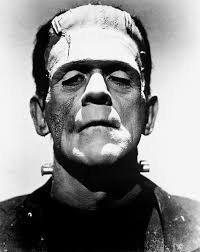Mary Shelley’s Frankenstein introduces The Monster as a creature that was created in the image of humankind. The Monster is capable of intelligence, speech, empathy, learning and all ranges of human emotion. When Shelley created The Monster, it possessed more human than subhuman traits and qualities; however, over the past century, the characterization of The Monster generally regressed from human to subhuman within popular culture. The evolution, or devolution, of The Monster into nothing more than an irrational and mindless brute became evident within the horror film genre, while comedy revealed the complexity of The Monster and, consequently, human nature through satire. This modern misconception of Shelley’s monster is due to the multiple transformations of the character within popular culture.
The initial transition into the most popular characterization of The Monster was set in motion by the early films of the Twentieth Century. Horror movies began portraying The Monster as a one-dimensional mindless and murderous brute. Ultimately, these films established a dominant subhuman image of The Monster as an archetypal monster within popular culture, which proved more popularly resilient than Shelley’s original, more human, creation.
The comedic interpretation, which began in the 1980s and 1990s, was introduced through films that satirized Shelley’s original narrative and character. These comedic interpretations revealed the complexity and diversity of The Monster, both as a character and metaphor. The nature of The Monster and its complexity within the comedic portrayals of Frankenstein are more closely related to the original character portrayed in Shelley’s novel, which is a stark contrast to the one dimensional archetype of the earlier horror films: The Monster displays human traits of intelligence, longing for companionship, speech and empathy. Considering The Monster’s transition from horror to comedy, or ascension from subhuman back to human, the next logical step along The Monster’s narrative within popular culture is to eclipse its humanity.
While the metaphorical ascension to super-humanity would be a tale of enlightenment, The Monster’s next step manifests through a trivial transformation into action super-stardom. In many of the most recent cinematic interpretations, Frankenstein has returned to his original level of intelligence and character complexity. The monster is no longer the fear-inducing creature he was made out to be. Now the role in the newest films created a being that combats supernatural creatures or terrorizes the hunters who chase him.
Ultimately, the complex character that originated in Shelley’s canon devolved into a mindless cinematic version of subhuman primal instinct, which is representative of the archetypal monster within the horror genre and more aligned with the consumptive natures and desires of popular culture. However, comedies and satirical interpretations of the classic explored The Monster’s complexity through a more critical lens. Frankenstein is a timeless classic, and the monster is undoubtedly going to live on through generations to come, regardless of his characterization as subhuman, human or superhuman. Satire is the inevitable criticism of anything popular and mainstream, and, accordingly, many great comedic interpretations have been made of this story. While it’s easy to debate whether The Monster should remain on the side of horror and satire, and be left out of the action film genre, it’s evident that the different characterizations of The Monster emphasizes our fascination with the complexity of human nature. Whether an archetypal monster or superhuman hero, The Monster’s non-linear transformation, through regression and growth, is, perhaps, The Monster’s most honest human trait of them all.


Very gooooood!
LikeLike
Great read! Good Points
LikeLike
How do you think religion plays thematically in Frankenstein? Is Dr. Frankenstein blasphemously playing God? If so, what does this say about him and The Monster?
LikeLike
Great article!
LikeLike
Probably the best article ever written – The New York Times
LikeLike
I agree, no more action films unless it’s someone hunting the brutish monster Frankenstein.
By the way, the guy above ^^ seems to know what he’s talking about
LikeLike
What an old story that lives on. e.g. Apple used Frankenstein in there Christmas commercial campaign last year and it was very well done.
LikeLike
Great paper ! Fun read
LikeLike
Very interesting, great read!
LikeLike
This is a very insightful analysis of how popular culture has made the Monster out to be. You brought some very interesting points, in fact, like most people I was influenced by the popular culture depiction of the Creature while reading Frankenstein at first. Your post highlighted the key elements of why I had these thoughts in the beginning. I agree with you when you say, “Whether an archetypal monster or superhuman hero, The Monster’s non-linear transformation, through regression and growth, is, perhaps, The Monster’s most honest human trait of them all.” I believe that the fact the Monster is not entirely evil nor completely good is what makes him out to be closer to humanity. Very interesting post, keep up the good work!
LikeLike
Definitely a great read. It is so true that the movie industry and pop culture have turned the novel’s key elements into brand new…creature… to such an extent that the vast majority of people do not even know the truth about Shelley’s nightmare.
LikeLike
Love the post!
-Anna lena
LikeLike